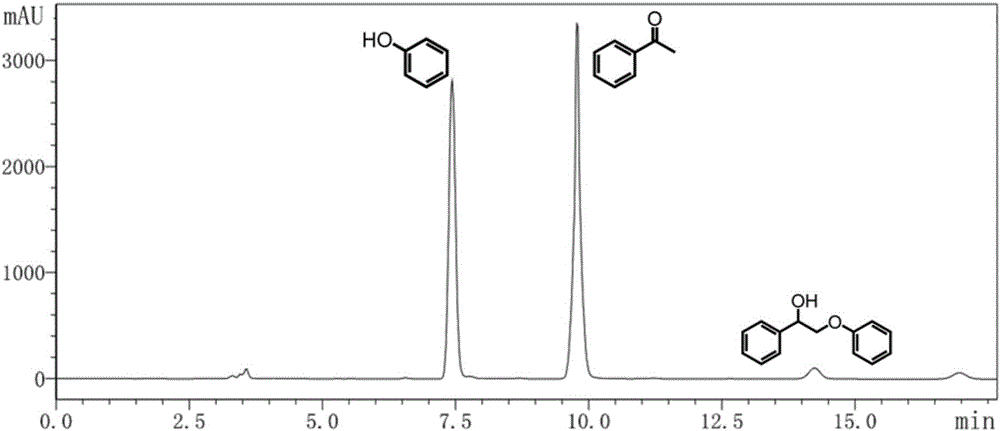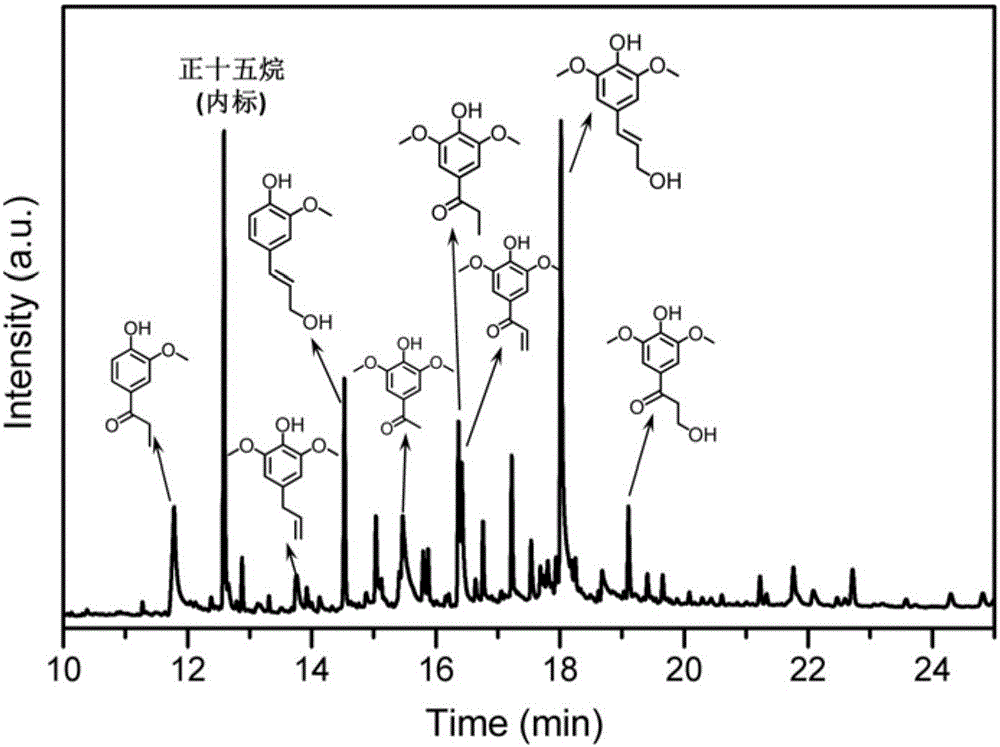Method for preparing aromatic compound through photocatalytic conversion of lignin and lignin-derived aryl ether
A technology of aromatic compounds and lignin, which is applied in the field of photocatalytic conversion of lignin and its derivative aromatic ethers to prepare aromatic compounds, can solve the problems of products staying in aromatic compounds, inability to realize lignin conversion, low yield of aromatic products, etc., to achieve The effect of low raw material prices, environmentally friendly raw material prices, and wide applicability of raw materials
- Summary
- Abstract
- Description
- Claims
- Application Information
AI Technical Summary
Problems solved by technology
Method used
Image
Examples
Embodiment 1
[0040] 5mmol of Cd(NO 3 )·4H 2 O and 5 mmol Na 2 S·9H 2 O was added to 80mL water respectively, and stirred thoroughly for 30min to obtain CdS nanoparticles. After being washed by centrifugation for 3 times, it was dried in a vacuum oven at 50°C for 12 hours. Take 10 mg of prepared CdS nanoparticles and 20 mg of phenylphenetole compound (2-phenoxy-1-phenylethanol), and add them to 5 mL of acetonitrile-water solution with a volume percentage of 50% to implement reaction (1). Vacuumize or feed inert gas under stirring to remove the oxygen in the system, turn on the 300W xenon lamp, and carry out the photocatalytic reaction under the condition of visible light for 24h. After the reaction solution was filtered, liquid chromatography analysis showed that the conversion rate of 2-phenoxy-1-phenylethanol was 88%, the yield of acetophenone was 81%, and the yield of phenol was 82%.
[0041]
[0042] figure 1 The ultraviolet-visible absorption spectrum of CdS nanoparticles in E...
Embodiment 2
[0044] 5mmol of Cd(NO 3 )·4H 2 O and 5 mmol Na 2 S·9H 2 O was added to 80mL water respectively, and stirred thoroughly for 30min to obtain CdS nanoparticles. After being washed by centrifugation for 3 times, it was dried in a vacuum oven at 50°C for 12 hours. Take 0.5 g of the prepared CdS, disperse it into 100 mL of methanol-water solution with a methanol volume fraction of 20%, add 5 μL of palladium chloride solution (0.1 g / ml) according to the loading capacity of 0.1%, stir and vacuumize. Reduction with 300W xenon light for 0.5h, to obtain CdS loaded with noble metal Pd nanoparticles, that is, 0.1% Pd / CdS. Centrifugal washing, drying and grinding for later use. Get 0.1% Pd / CdS nanometer catalyst that 10mg makes and 20mg phenylphenetole compound [2-(4-methylphenoxy group)-1-phenylethanol], join in the acetonitrile solution of 5mL 100% and carry out reaction ( 2). Vacuumize or pass inert gas under stirring to remove oxygen in the system, turn on a 1500W halogen tungste...
Embodiment 3
[0047] 5mmol of Cd(CH 3 COO) 2 and 5mmol of Zn(CH 3 COO) 2 were added to 80mL water respectively, stirred by magnetic force for 30min, and then added 20mmol CH 3 CSNH 2 , continue to stir for 30min, transfer to a 100mL autoclave, heat up at a rate of 5°C / min, and keep at 180°C for 24h to obtain Zn 0.5 Cd 0.5 S nano semiconductor. Take 20mg of Zn made 0.5 Cd 0.5 S nanocatalyst and 20mg phenylphenetole compound [2-(2-methoxyphenoxy group)-1-phenylethanol], join 5mL acetonitrile volume percentage and implement reaction in the solution of 50% acetonitrile-water (3 ). Vacuum or inert gas was introduced under stirring to remove the oxygen in the system, then a 500W mercury lamp was turned on, and the photocatalytic reaction was carried out for 1 h under the condition of visible light. After the reaction solution was filtered, liquid chromatography analysis showed that the conversion rate of 2-(2-methoxyphenoxy)-1-phenylethanol was 68%, the yield of acetophenone was 64%, an...
PUM
 Login to View More
Login to View More Abstract
Description
Claims
Application Information
 Login to View More
Login to View More - R&D
- Intellectual Property
- Life Sciences
- Materials
- Tech Scout
- Unparalleled Data Quality
- Higher Quality Content
- 60% Fewer Hallucinations
Browse by: Latest US Patents, China's latest patents, Technical Efficacy Thesaurus, Application Domain, Technology Topic, Popular Technical Reports.
© 2025 PatSnap. All rights reserved.Legal|Privacy policy|Modern Slavery Act Transparency Statement|Sitemap|About US| Contact US: help@patsnap.com



